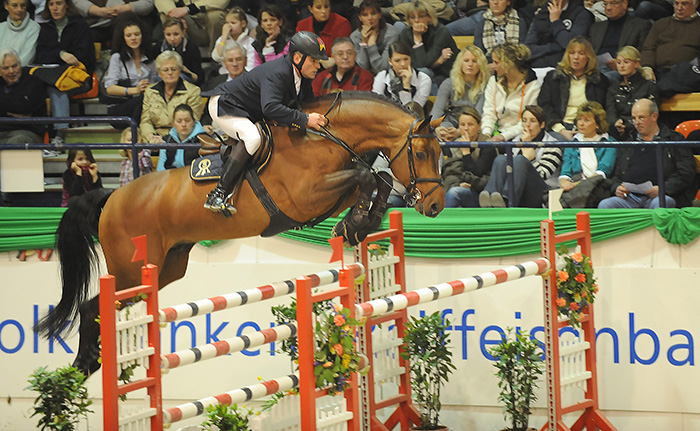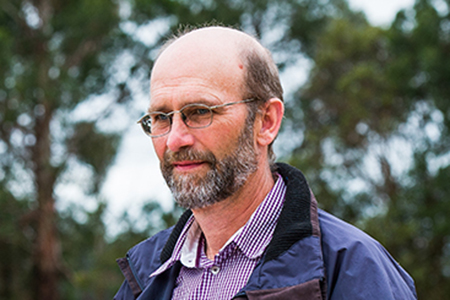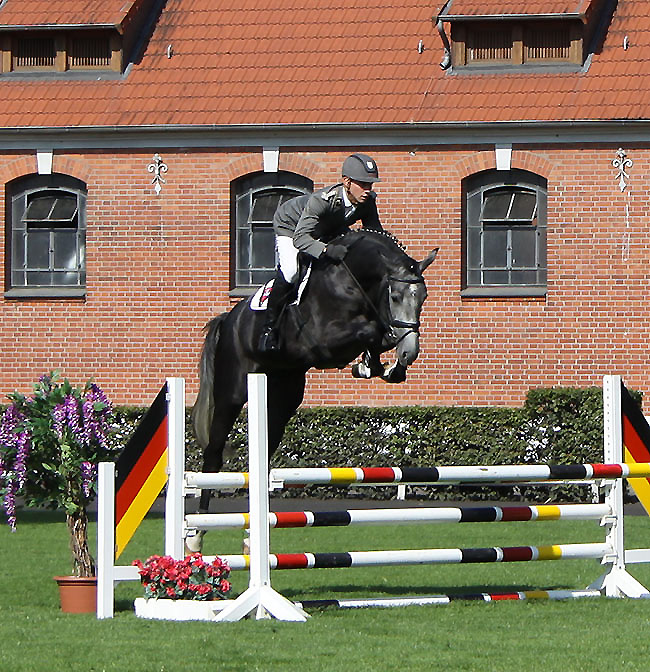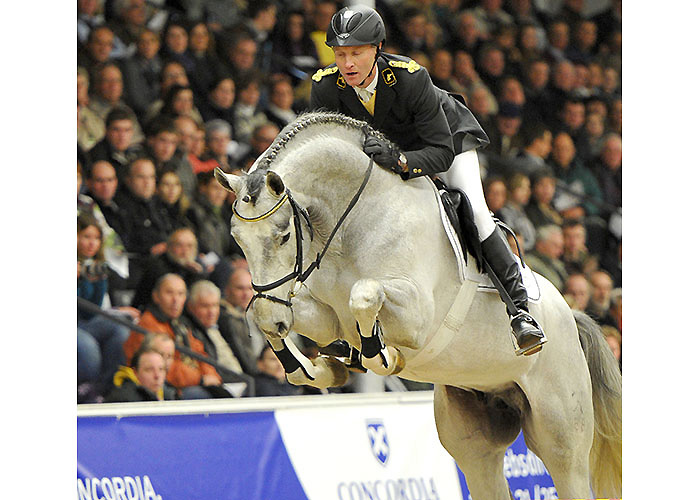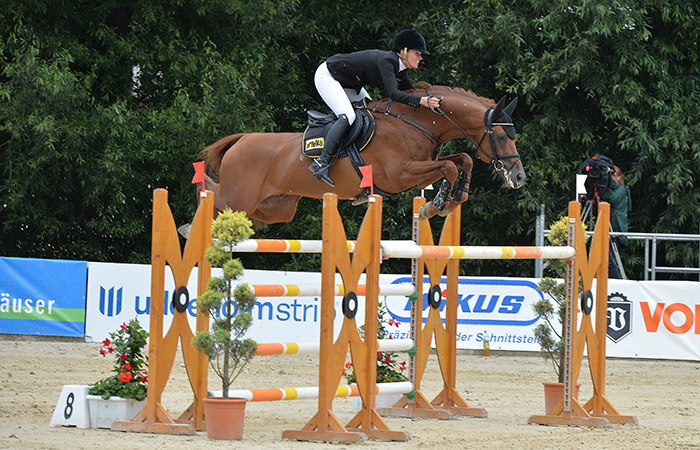The facts and figures of jumping breeding
by Christopher Hector and Gemma Alexander
I find it intriguing and disturbing that even recent history can just ‘disappear’. Right now I cannot find out just when the first WBFSH sires rankings appeared. The earliest I can find in my personal library is the 1993 / 94 WBFSH media guide, where Dirk Zagers supplied a fine analysis of the top jumping stallions. He looked at two tables, the first ranked sires according to the number of offspring in international competition, the second according to WBFSH scores, and there’s not a dud sire in either.
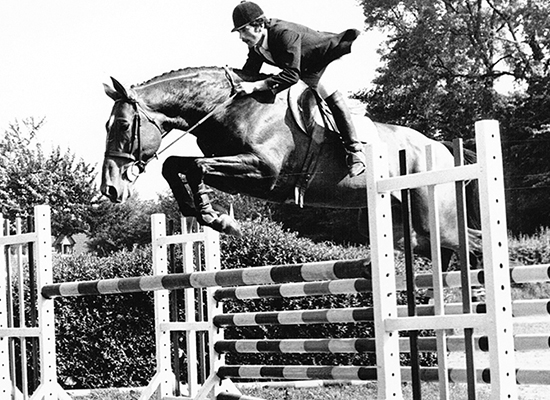
Jalisco – equal number one
Ranked by offspring:
- Jalisco B – 8 progeny
- Ramiro – 8
- Landgraf – 5
- Polydor – 5
- King of Diamonds – 5
- Grannus – 4
- Pilot – 4
- Lord – 4
- Feinschnitt I – 3
- Zeus – 3
- Uriel – 3
- Clover Hill xx – 3
- Irco Marco – 3
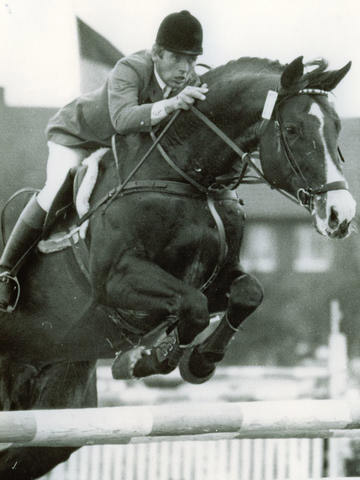
Ramiro
The cast was much the same for the rankings according to WBFSH scores:
- Jalisco B – 1841
- Ramiro – 1732
- Landgraf – 1334
- Polydor – 1277
- Grannus – 1221
- King of Diamonds – 1166
- Pilot – 1079
- Irco Marco – 1033
- Zeus – 935
- Lord – 835
While in the past the WBFSH formula produced some fairly strange Dressage Sires Rankings – like having the Latvian warmblood, Rebuss, which sired just one horse – Ulla Salzgeber’s Rusty – as the world’s number one – the jumping rankings have been consistently spot on.
We have already discussed this year’s WBFSH jumping sires rankings, but the WBFSH is no longer the only player in the rankings field. The website hippomundo has been tweaking the formula and looking at different ways to taking the pulse of the world of breeding. I recently looked at their rankings of breeders and more recently they have produced an interesting series of stallion rankings.
It is striking that while hippomundo uses the earnings of progeny, and the WBFSH rankings are based on points, the result is almost identical. The top three – Chacco-Blue, Diamant de Sémilly, Toulon, are the same, while Casell is 4th with hippomundo, and 5th on the WBFSH ranking, swapping places with Mylord Carthago.
Sixth spot is the only place there is a substantive difference, on the WBFSH rankings, this is occupied by Berlin, on hippomundo, it’s Numero Uno. Seventh through to ten features pretty much the same stallions on both charts with minor re-shuffles: Eldorado van de Zeshoek, Kashmir van Schuttershof, Diarado, Cardento, on the hippomundo rankings, Kashmir van Schuttershof, Cardento, Nabab de Rêve and Diarado, on the WBFSH.
Story continues below the advertisement
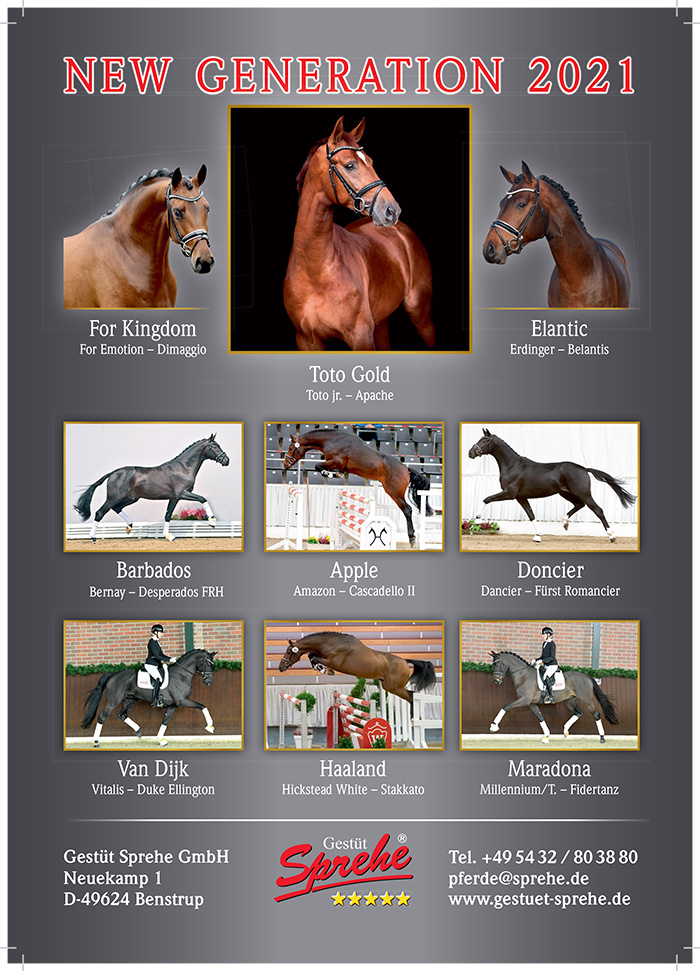
Another way of feeling the pulse of the breeding scene is looking at the results of the stallion licensings. To my great regret I missed the KWPN stallion show this year because of Covid. At the Dutch licensing I always try to sit next to my Dutch colleague Jenneke Smit, since she has an encyclopaedic knowledge of KWPN breeding and a wonderful eye.
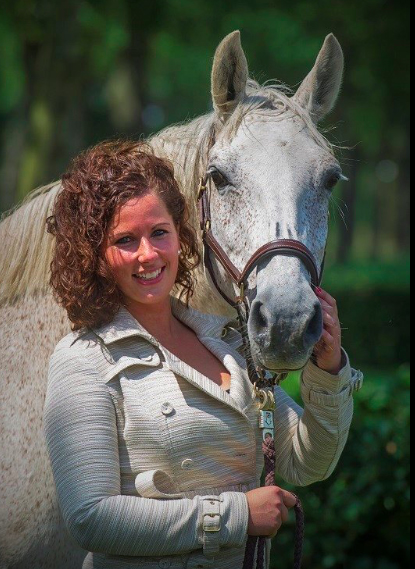
I asked her what her major impressions were of this year’s stallion crop:
“The dam lines were quite interesting and it was a varied group of sires. For example, twelve of the 48 selected stallions are owned by the VDL stud, and they used quite some Belgian stallions for their breeding, such as Erco vaan’t Roosakker (premium stallion) and Thunder vd Zuuthoeve. Apardi also showed interesting sons out of his second crop (three were selected) as well as Quabri de l’Isle (two selected stallions owned by Egbert Schep). The Belgian influence was remarkable this year, but it is not the first nor the last time.”
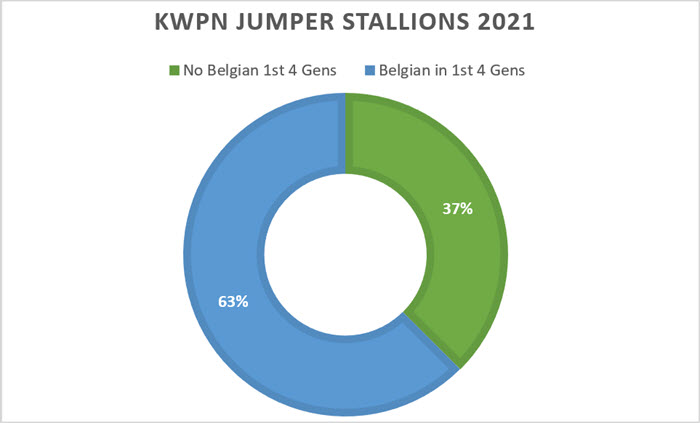
The other stallion with multiple sons into the performance test was Baltic VDL.
The stallions awarded premium status were Nouri W (Cohinoor VDL x Carrera VDL, bred by K.J. van Weperen from Oosterwolde) owned by VDL Stud, Night Life VDL (Erco van ’t Roosakker x Arezzo VDL) of breeder VDL Stud and Saltador ter Putte (For Pleasure x Diamant de Semilly, bred by Familie De Maertelaere) of Egbert Schep as were ZA La Minute Z (A La Carte NRW out of Nuhr ster pref prest by Libero H) of breeder Jacoba Stud from Wijster and co-owner Reinie Tewis, Niwyruso H (Baltic VDL out of Wyrusa H ster pref prest PROK by Corland, bred by Anne Jan Hazenberg from Opende) of VDL Stud and Nirvana V&V (Farfan M out of Sascha keur prest by Fuego du Prelet) of breeder Herman Voort of Den Ham.
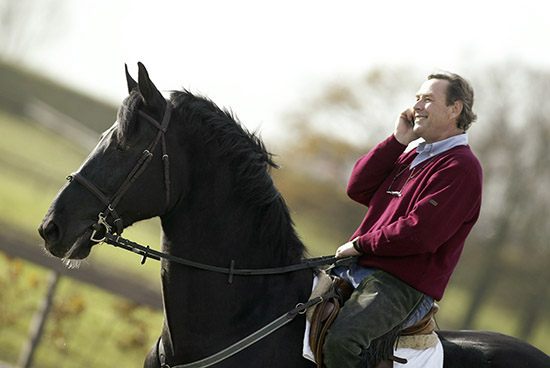
I asked Egbert Schep why he had gone to Quabri de l’Isle ( sire Kannan) to cover his mares – what do you like about him?
“What is there not to like about him? It’s a beautiful horse and he jumps in the highest level – he jumped at the Olympic Games. With Kannan, you need the right combination with the mare.”
Do you like the fact that he is a beautiful Kannan, because there are a lot of very plain Kannans?
“That’s right 100% – Kannan does not breed the most beautiful horses but he himself is a fantastic type, a very beautiful horse. What is also important is that the horse has a super mind and that’s what I like.”
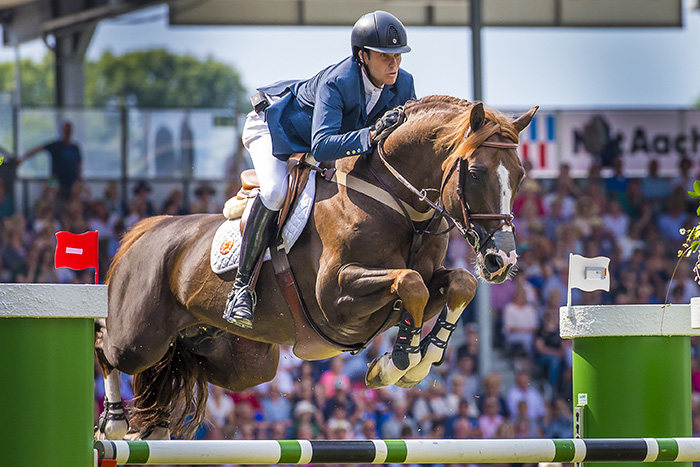
Quabri de l’Isle
Do you have to find a particular mare to go with Quabri?
“For sure, but that is the art of breeding. We always talk about stallions but we should talk about mares. Both of the mares that produced the stallions at the licensing, they are older mares, and you know what they breed. Both of them, they have a bit of character, they breed a bit character actually, and I like the character of Quabri de l’Isle – that’s a very steady horses, he is always the same, easy to ride, and that is why I pick him for those mares.”
My colleague Jenneke Smit remarked on the success of the Belgian bred horses, and one of your five licensed stallions, Saltador ter Putte (For Pleasure / Diamant de Sémilly) is Belgian bred – how did breeding in Belgium get so strong – once they were the poor cousins of the Dutch?
“But nowadays we have a European breeding, we use all the same blood in the whole of Europe. It is just a question of crossing. If you know your mare right, then you can pick out the good stallion.”
But why do you think the Belgians have been so good at it? If we combine the three Belgian books into one, they would lead the world in jumping breeding…
“Maybe, but in figures it’s not till now, the leader is still Holland. Holland on the rankings is still number one but it is true Belgium has very strong breeding. In Belgium, years ago they started selecting only on jumping and not so much on the exterior of the horse, and if you select on less points, then you get a quicker result.”
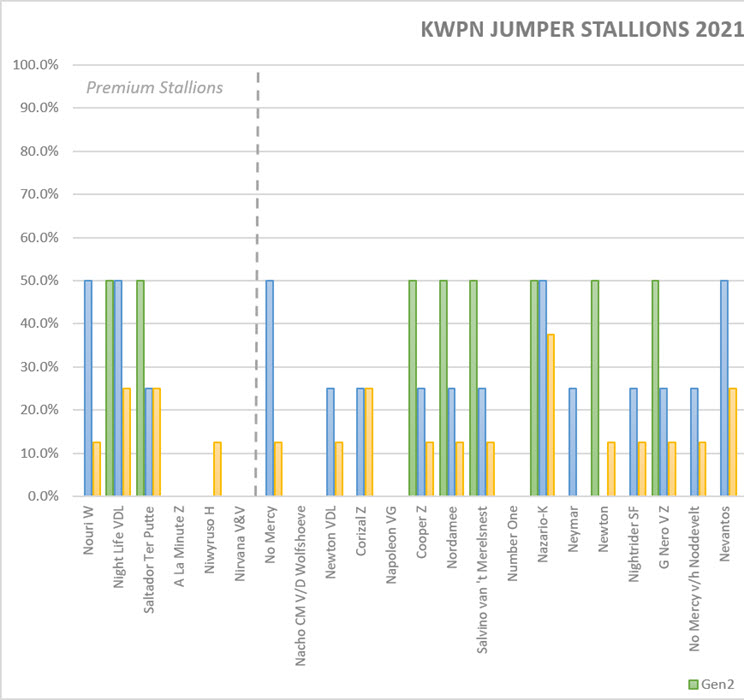
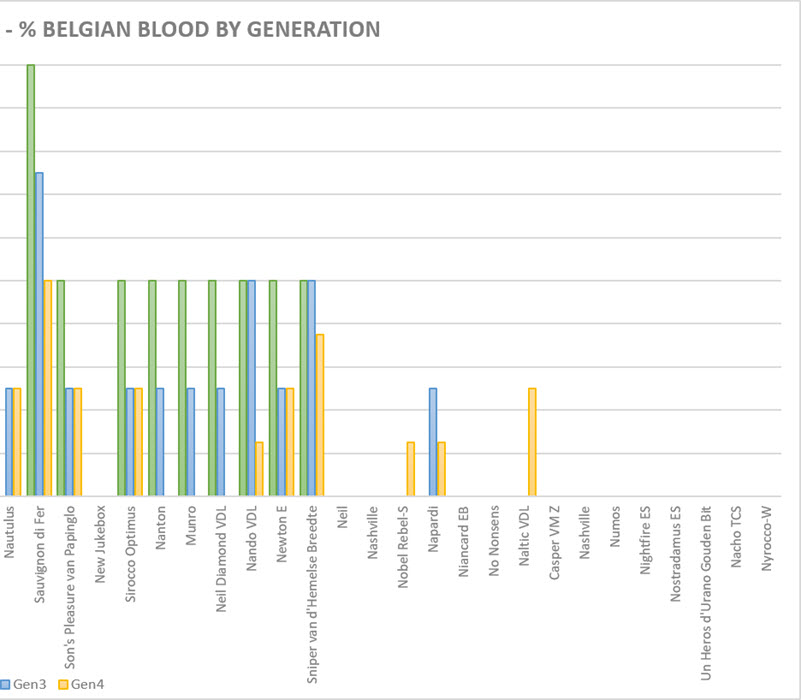
Do you think in Holland you should be looking less at trot and type and more just on jumping?
“For a while they did that, but now they look at both. We had this year, a very very strong year for the jumpers in Holland.”
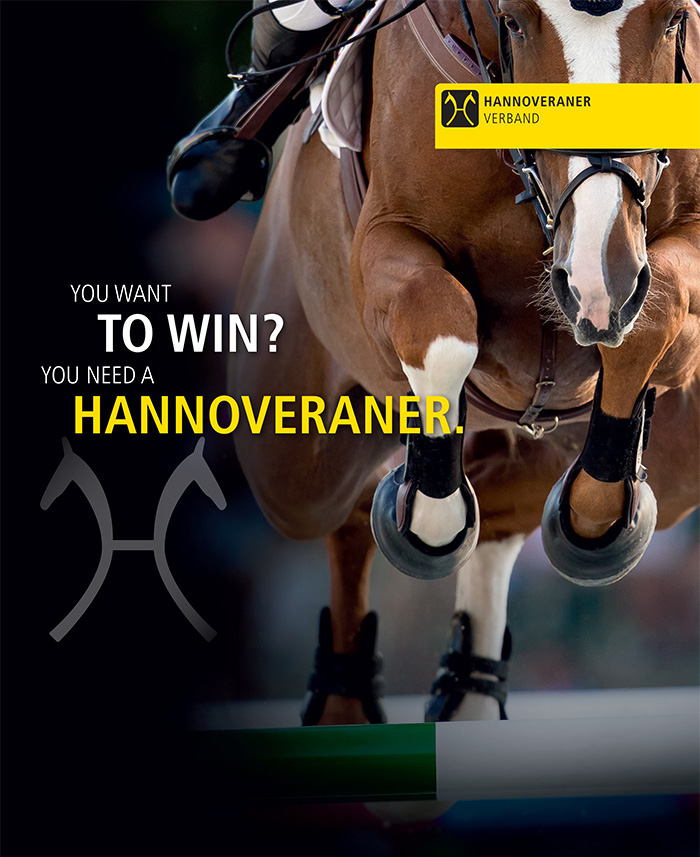
Meanwhile over the border in Germany, yet another edition of the Hanoverian Stallion Book had rolled off the presses, and that means my friend Ludwig Christmann, who edits the stallion book, was also hard at work on his analysis of the stallions. I am grateful to the Hanoverian Verband for supplying this translation:
QUALITY RUSHES TO THE TOP
By Dr. Ludwig Christmann
The result for Hannover in the breed value estimation young horse classes is outstanding. The first nine stallions in the top list are Hanoverians, five of which – including the top four – belong to the State Stud Celle. The results of mare tests, of the various types of stallion performance tests and of jumping horse classes are entered into the breed value estimation young horse classes. The goal of this breed value is obvious: We would like to identify the first heredity tendencies as early as possible. The free-jumping evaluations are an essential part of the database. Granted, not every horse that delivers a superior free-jumping performance eventually fulfills the great hopes under saddle, and, vice versa, not every highly successful jumper was top in the free-jumping chute. However, it is indisputable and also scientifically proven that the evaluations of the free-jumping have validity and are indispensable for the assessment of young jumping horses.
A surprise connected with sadness
It definitely is quite a surprise, which is unfortunately connected with sadness, that Quaid’s son Qualito (breed value 160), born in 2011, holds the leading position in the breed value estimation young horse classes. He immediately rushed to the top position, as soon as his breed values were published. Sadness arises, because this promising young producer passed away far too early in 2018; his sire, the also highly successful Quaid also died last year. Helmut Habermann from Haenigsen bred Qualito out of St.Pr.St. Starlight by Salito/Calypso II.
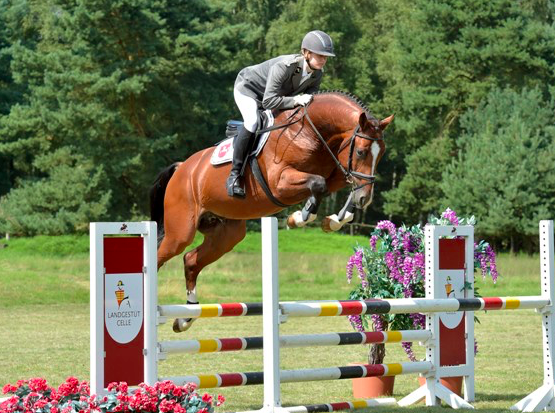
Qualito (photo Kiki Beelitz)
He stems from the superior damline of Norm, which calls the Habermann farm its home already since 1921 for exactly 100 years. Internationally successful sport horses emerged from this line like Elwood by Esprit, the winner of the Grand Prix of Neumuenster in 2003, or Firth of Lorne by For Pleasure, the winner of the Grand Prix of Hamburg in 2017 with rider Katrin Eckermann. The 2006-born St.Pr.St. Starlight obtained the optimum score of 10 for her jumping ability in the mare test. She delivered a total of seven foals by the sire Quaid including the 2013-born Qualibro and the one-year-older IB Qualita. Both already are successfully competing at the S-level at a young age. Qualibro lives at the barn of world champion Simone Blum and already competes at the international level. IB Qualita also found a home in a top barn. She already won an international, S-level class with rider Tim Rieskamp-Goedeking and placed very well in the Grand Prix of Opglabbeek/BEL and in the Grand Prix of Oldenburg in November of 2020.
The performances of the individuals as well as its relatives are considered for the breed value estimation. It includes successful siblings as well as descendants. Qualito obtained outstanding assessments in his 30-day test 2014 (overall score for jumping 9,58) and in jumping horse-classes. For instance, with rider Heiko Tietze, he won a total of ten M-level jumping horse classes.
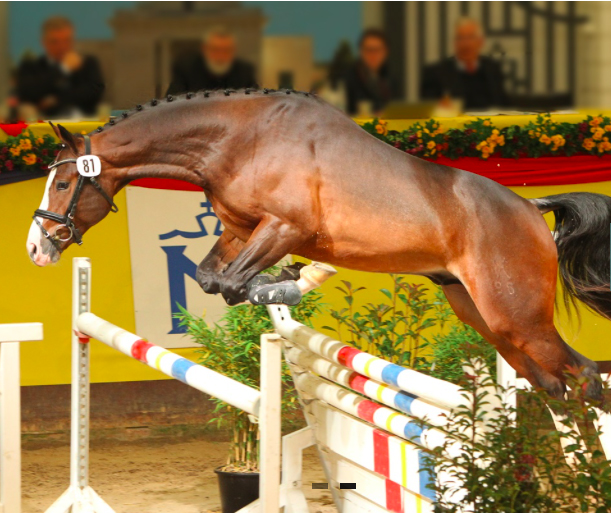
Quudo Boe – standing at Landgestüt Redefin
An approved son, the 2017-born Quudo Boe out of a dam by Embassy (breeder: Helmut Boettcher, Rehlingen) received above average scores for his predisposition for jumping (9,0) in his 14-day test in 2020. A total of 13 mares from the vintages of 2015 and 2016, which was stronger by numbers, were awarded the Hanoverian premium. Ten of them completed the mare test including eight obtaining a jumping score of 9 and better. The top score of 10 was awarded three times. 26 descendants – mainly from the foal vintage of 2016 – already are successful competitors mainly in jumping horse classes at the A-level in accordance with their ages. Often Qualito’s sons and daughters were either the winners or placed well.
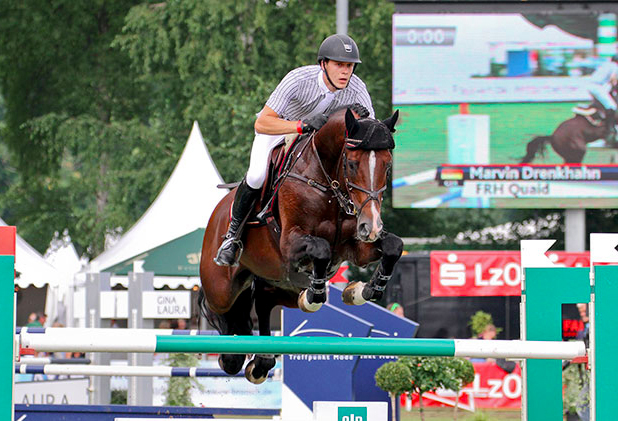
Quaid
Let us take a quick look at Qualito’s sire Quaid. The national champion from 2009 (breeder: Friedhelm Vehlber, Espelkamp; owner: Stud Staj Mustang, Czech Republic) is missing in the chart, since he was not registered for 2020 and 2021. His breed values for jumping 144 (Hanoverian breed value estimation) and 127 (FN, highest obtained level) would have been high enough for his inclusion in the chart. The Yearbook Stallions shows 33 descendants with successes at the S-level for the 2004-born stallion including four with successes over 1,55 meters. His most successful descendant is IB Querido (prize winnings of 37,153 Euros) out of a dam by Graf Sponeck. The dam is out of St.Pr.St. Marquesa, who also delivered Lissaro van de Helle. IB Querido also lives in the barn of Tim Rieskamp-Goedeking and already has impressive international successes to show for. In January 2020 as a nine-year old, he won the Grand Prix of Kronenberg/NED. Later on, he added second placements in Opglabbeek/BEL and in the Grand Prix of Braunschweig to his show record.
Diacontinus
Qualito took over the leading position in the ranking of the rising stallions from the sire Diacontinus. With a very good breed value young horse classes of 156, Diacontinus now follows in second place. The son of Diarado/Argentinus (breeder: Klaus Juergens, Sehnde-Bolzum) is one of the most sought-after Hanoverian jumper stallions of the past years. He is a reliable producer. His descendants are eminent, large-framed horses of good size (breed value size 117) and good substance. They are talented and rideable.
His oldest foal vintage is from 2014. 35 of his offspring already successfully participated in jumping horse-classes and in M-level jumper classes. It can be assumed that a large number of these will transition into the S-level this coming season. We would like to highlight his son Damaskus out of a dam by Alexis Z (breeder: Dr. Joern Bramstedt, Bremerhaven). With rider Eiken Sato, Damaskus successfully participated in the National Championships for five-year olds in 2020 finishing on an excellent fifth place.
Diacontinus’ breeding record is impressive. Out of 129 registered daughters, almost half, 58, were awarded a Hanoverian premium. Ten sons were approved.
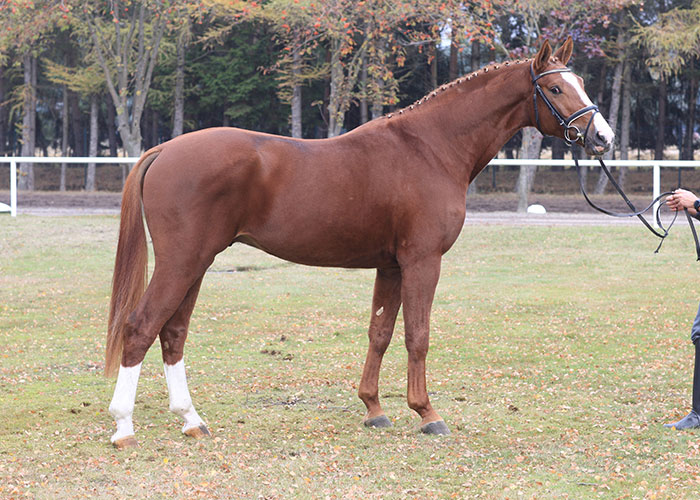
Stanley
The top ranking for the breed value estimation young-horse classes once more reveals the superior importance of Stakkato for the Hanoverian jumping horse breeding. He is in fourth place framed by his sons Stanley (3rd), Stakkato Gold (5th) and Sampras (6th). Stakkato is the dam’s sire of Perigueux (7th) and Chacco Chacco (9th). Already last year, these stallions were in the top ten. I would like to add a few words to the just 12-year old Sampras, who is not as well known. He has a first-rate pedigree. His dam is Asulina by Achill Libero H. Asulina has already delivered the internationally successful and approved stallion Wallenberg by Stakkato. Dr. Jacobs GbR from Bierbergen bred Sampras. The stallion was briefly used for breeding in Germany before moving to South Africa, where he stands at stud at the exemplary breeding farm Callaho.
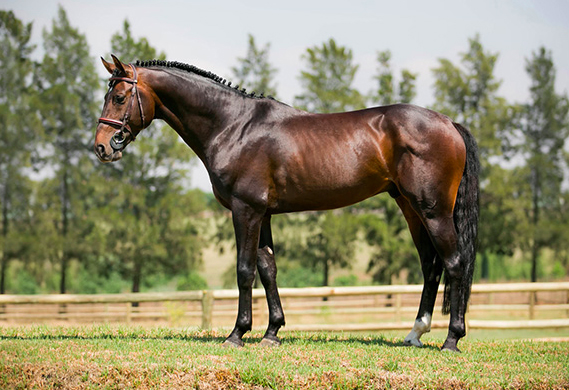
Sampras
For Sampras’ excellent completion of his stallion test, he was awarded the Stakkato-Prize. His very few descendants are convincing. The oldest were seven years of age in 2020. Two of them already successfully competed at the international level. Swedish Dynamite out of a dam by Quality (breeder: Christian Pfeil, Bremerhaven) has already won an S-level jumping class with rider Rikke Haastrup Kristensen. Jens Baackmann successfully competed Sunny Boy out of a dam by Acorado (breeder: Ingrid Beutler, Isernhagen).
Grey Top – Kiki Beelitz image
The descendants of the 2007-born stallions Grey Top and Chacco Chacco are one year older. They are at the age, when the first ones arrive at the S-level of competitions. Celle’s state stud sire Grey Top by Graf Top/Singular Joter (breeder: Emiliano Lonzi, Fauglia-Pisa/ITA) is very popular with the breeders. He already has 19 descendants with successes at the S-level; two of them already compete in jumping classes up to 1.50 m. Geronimo – born in 2012 and bred by Hans-Heinrich Schmidt, Haenigsen – is one of them. Sven Fehnl successfully rides him at the international level. The pair was already victorious at the S-level. Geronimo’s pedigree is the G-line, through and through. Via the dam’s sire Glueckspilz and the second dam Grandlage, a right sister to the successful producers Grundstein I and II, he has a strong blood connection to Grande and Gotthard. Grey Top probably is the most hopeful representative of the G-line. He totally convinced with producing fabulous mares, approved stallions and popular auction horses. The signs are favorable that his offspring will bring honor and glory to their sire at the top level of competition.
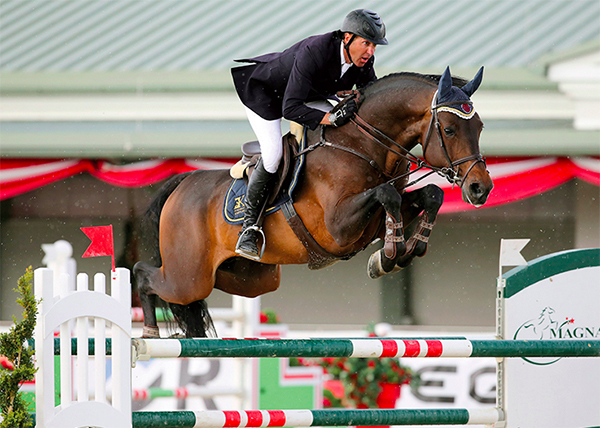
Chacco Chacco
Chacco Chacco is a son of the superior Chacco-Blue, who continues to be the number one in the list of the WBFSH-world ranking of jumping-horse producers. His dam is by Stakkato. Klaus Juergens from Sehnde-Bolzum bred him and the breeding farm Tannenhof, which is located near Wiesbaden, owns him. As a nine-year old, Chacco Chacco was highly successful in 1.50 m-classes with rider Andreas Knippling.
The results of 42 horses, which competed in jumping-horse classes, constitute the main basis for his breed value young-horse classes. Only three daughters completed a mare test. How valuable is the breed value young-horse classes? Can we derive of its information that offspring of stallions with a high young horse-breed value will do well at the higher level of competitions or even at the international level?
To answer this question, looking at older stallions in this ranking deems useful. These would be stallions like Stakkato, Stakkato Gold, Perigueux, Catoki, Heartbreaker and Cornet Obolensky – all stallions rank in the top ten. They have high breed values young-horse classes and are recognized as producers of horses competing at the international level of jumping. With a breed value “highest attained level” (HEK-breed value) of 139, Perigueux is in the top ten percent of all stallions in the breed value estimation; Stakkato (BV 145), Stakkato Gold (BV 162), Catoki (BV 148) are in the top five percent. Heartbreaker (BV 177) and Cornet Obolensky (BV 175) are in the top one percent and rank internationally among the absolute top producers. Hence, it is very probable that a stallion with a high breed value young-horse classes develops into a producer of horses suitable for jumping classes at the higher levels.
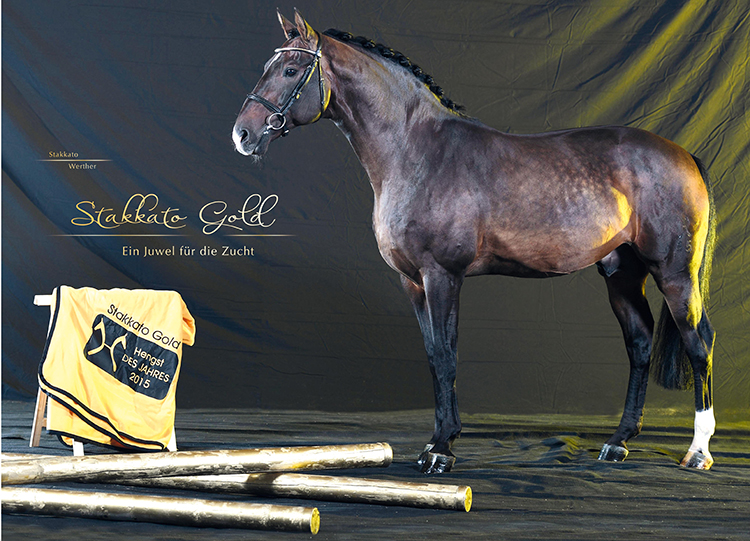
Stakkato Gold remains at the top
Stakkato Gold by Stakkato/Werther (breeder: Arend Kamphorst, Breeding Farm Prieros) is the Hanoverian stallion with the highest HEK-breed value. Stakkato Gold stands at Stud Sprehe, where he is available for breeding. The Hanoverian Stallion Of The Year 2015 is the poster child for the breeding of Hanoverian jumping horses. He is sought-after by breeders of all important jumping horse-societies. With a total of 222 successful jumpers, the Yearbook Stallions lists 58 horses with successes at the S-level including 22 with successes over 1,50 meters and higher.
Five descendants have successes in 1.60 meter-classes. The 2011-born, Oldenburg descendant Solid Gold out of a dam by Calvin, the world champion of young jumping horses in 2018 won the most prize money with rider Christian Ahlmann. As a nine-year old, he already successfully competed in 1,60 meter-classes. The 2009-born Hanoverian Solero bred by Stud Sprehe out of a dam by Graf Grannus is also highly successful with winnings totaling EUR 124,777. Joern Sprehe already won 20 jumping classes at the S-level with Solero.
Additional Hanoverian or Rhineland stallions, which belong to the best five percent because of their breed value for highest attained level, are the Stallion Of The Century, For Pleasure (BV 159), Zandor by Zeus bred in the Rhineland (BV 159), the 1992-born Grandilot by Grandeur (BV 151), the 1988-born Lux Z by Lord Calando (BV 150), Stakkato (BV 145) and Ucato by Stakkato (BV 144).
Cornet Obolensky and Chacco Blue are the only two producers in the ranking of the top ten for the breed value of highest attained level, whose majority of breeding activities took place in Germany. The breed value of all other top ten-stallions is predominantly based on descendants, which were raised in other countries. This includes two international top producers with Hanoverian origin. Kashmir van het Schuttershof has the second highest breed value for highest attained level: 182. The third dam of this stallion, which was bred in Belgium, is the Hanoverian mare Ghana by Gotthard out of the damline of Norm, out of which – as mentioned earlier – Qualito also descends.
Back to the roots
The in Belgium bred Ogano Sitte (BV 170) by Darco brings the Hanoverian genetics back to Germany. As is well known, his sire, the famous Darco, descends from the Hanoverian stallion Lugano van La Roche. Gute Sitte by Grande established the damline. You find Gute Sitte in the pedigree of Ogano Sitte in the third generation. This daughter of Grande was out of a Thoroughbred mare. At the Olympic Games in Montreal/CAN, she won the team bronze medal with Eric Wauters from Belgium. Ogano Sitte already produced numerous international top horses. Since a few years, he stands at stud at the breeding station Boeckmann in Lastrup.
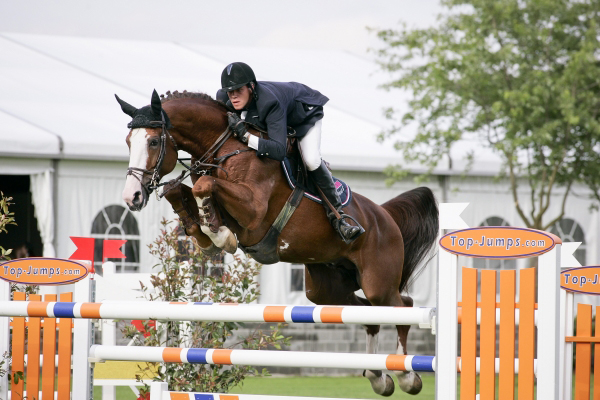
Ogano Sitte
Admittedly, the inclusion of foreign stallions in the national German breed value estimation requires further analyses. This already became an issue, when the breed value for highest attained level was introduced. For stallions, which are used in foreign countries, it was decided that they not only fulfill the requirements for the HEK breed value estimation but also for the breed value estimation young-horse classes. The attempt was to avoid considering stallions for the breed value estimation with only older descendants, which were imported into Germany. The HEK-breed value estimation only delivers comparable results, if not only the most successful descendants of a stallion are considered but also the so-called normal horses, which only compete in the lower levels. Every stallion produces such offspring as well. If the pre-selection is too big in favor of descendants, which compete at the higher levels, then the comparability is restricted.
Want to breed your own showjumper? Check out the wonderful range of European bloodlines available via frozen semen at International Horse Breeders
Including many of the stallions featured in these Rankings including – Perigueux



